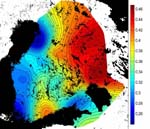

Digital archive of Finnish Folk Tunes

By the end of the 19th century, the Finnish Literary Society (SKS) had collected tens of thousands of folk tunes from all over the Finland (see maps for more details). Most of the fieldwork was done prior to the advent of recording technology and therefore the material consists mainly of transcriptions. The impetus for collecting tunes from all around the nation came from the rising nationalism that already had produced the Finnish national epic, Kalevala (1835) and Kanteletar (1840). By the end of the century, a Finnish music scholar, Ilmari Krohn, had started to edit and publish the collected folk songs in separate volumes, all falling under the name Finnish Folk Tunes (Suomen Kansan Sävelmiä). The volumes included about 9000 folk tunes and they were published between the years 1898-1933. This collection is musically comprehensive, nationally important and thoroughly documented.
The Finnish Folk Tune -collection consists of five main subcollections that were originally published as separate book series and volumes. The last column on the following table refers to the abbreviation used in the digital version intended for research purposes. Each subcollection is briefly characterized below the table.
| Collection | Series | Volume | Year | Abbrev. |
| Spiritual Folk Songs | I | 1898 | HS1 | |
| Folk Songs | II | 1 | 1904-1907 | LS1 |
| Folk Songs | II | 2 | 1908-1912 | LS2 |
| Folk Songs | II | 3 | 1932 | LS3 |
| Folk Songs | II | 4 | 1933 | LS4 |
| Folk Dances | III | 1893 | KT1 | |
| Rune Songs from Ingria | IV | I | 1910 | RS1 |
| Rune Songs from Karelia | IV | II | 1930 | RS2 |
| Kantele- ja jouhikko Tunes | V | 1928 | KJS | |
The original introductions (in Finnish) of the books are available from here. Series I, II and III were published by Ilmari Krohn. Series IV was published by Armas Launis, and series V by A. O. Väisänen.
Spiritual Folk Songs includes spiritual songs and hymns from the Old Hymn Book (1701). For the most part, the songs are from the Hymns of Sion and Spiritual Songs for Devoted Souls. Spiritual Folk Songs has two sections: chorals and adaptations of secular songs and original spiritual songs. Inspired by this collection, Krohn wrote his dissertation, On the Origin and Character of Finnish Spiritual Folk Songs, which was printed in 1899.
Folk Songs is the most extensive series in the collection with its 4842 songs. The songs are grouped according to the quality of the melodic cadences. After the publication, the Finnish Literary Society (SKS) received more songs and their variations. Due to funding problems, the publishing was aborted in 1912. The process continued, however, in 1932, and the Folk Songs series was completed in 1933.
Folk Dances contains instrumental music or songs that have been both sung and played. Unless stated otherwise, the songs are played on the violin. Dance tunes were commonly sung and are also included in this series. The collection includes some cowherd’s tunes and cow calls, which were originally intended to be published as a separate series.
Rune Songs is divided into two sections: Ingrian and Karelian. The most notable collectors of Ingrian Rune Songs were A. Lähteenkorva, E. Levon and A. Launis. Later, Launis made nearly 200 phonograms of Rune Songs facilitating the transcription process. The collection is divided into three main groups: laments, children’s tunes and the actual Rune Songs. Most of the Karelian Rune Songs were collected by A. Lähteenkorva, and the collection was edited in the same way as the Ingrian Rune Songs.
Kantele and Jouhikko Tunes contains descriptions of the structure of these instruments and their playing techniques. Several players are also introduced, including photographs as well as notated examples including fingering information. Most of the tunes were collected by A. O. Väisänen.
The original collection was digitized in 2002-2003. The task was performed at the University of Jyväskylä (see authors) and supported by various partners. A total of 8613 tunes and their relevant details (notation, key, meter, place of collection, lyrics, collector and so on) were entered into a database, available as the Digital Archive of Finnish Folk Tunes (http://www.jyu.fi/musica/sks/index_en.html). This web site, which is freely available, has a  search engine that enables tunes to be searched by a keyword, collection, musical type, geographical location and musical content. The digital version also includes maps describing geographical distributions of the songs and other musical details.
search engine that enables tunes to be searched by a keyword, collection, musical type, geographical location and musical content. The digital version also includes maps describing geographical distributions of the songs and other musical details.
Music databases are useful tools for the basic research on the musical structure, classification and other such large-scale analytic and empirical techniques. Databases also facilitate the development of technical applications, such as various musical search and query methods (e.g., query-by-humming or finding melodic using symbolic information) that all fall under the general term of Music Information Retrieval (MIR, see ISMIR, The International Conferences on Music Information Retrieval and Related Activities). Hence, the digital archive of Finnish Folk Tunes will be used for various research purposes:
Publications related to the Digital archive of Finnish Folk Tunes: